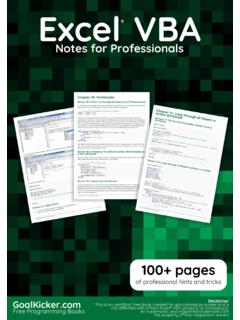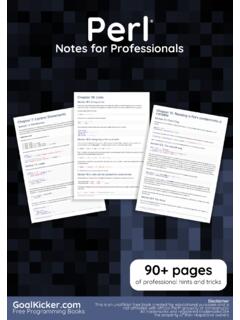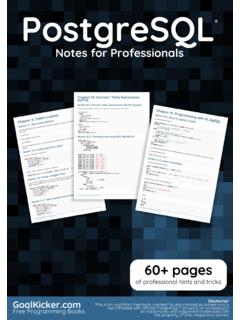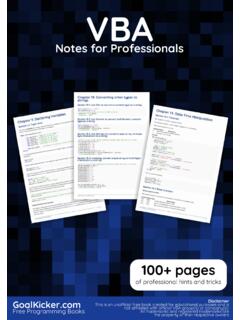Transcription of Entity Framework Notes for Professionals - goalkicker.com
1 Entity FrameworkNotes for ProfessionalsEntityFrameworkNotes for Programming BooksDisclaimerThis is an uno cial free book created for educational purposes and isnot a liated with o cial Entity Framework group(s) or company(s).All trademarks and registered trademarks arethe property of their respective owners80+ pagesof professional hints and tricksContentsAbout 1 .. Chapter 1: Getting started with Entity Framework 2 .. Section : Installing the Entity Framework NuGet Package 2 .. Section : Using Entity Framework from C# (Code First) 4 .. Section : What is Entity Framework ? 5 .. Chapter 2: Code First Conventions 6.
2 Section : Removing Conventions 6 .. Section : Primary Key Convention 6 .. Section : Type Discovery 6 .. Section : DecimalPropertyConvention 7 .. Section : Relationship Convention 9 .. Section : Foreign Key Convention 10 .. Chapter 3: Code First DataAnnotations 11 .. Section : [Column] attribute 11 .. Section : [DatabaseGenerated] attribute 11 .. Section : [Required] attribute 12 .. Section : [MaxLength] and [MinLength] attributes 12 .. Section : [InverseProperty(string)] attribute 13 .. Section : [ComplexType] attribute 14 .. Section : [ForeignKey(string)] attribute 15.
3 Section : [Range(min,max)] attribute 15 .. Section : [NotMapped] attribute 16 .. Section : [Table] attribute 17 .. Section : [Index] attribute 17 .. Section : [Key] attribute 18 .. Section : [StringLength(int)] attribute 19 .. Section : [Timestamp] attribute 19 .. Section : [ConcurrencyCheck] Attribute 20 .. Chapter 4: Entity Framework Code First 21 .. Section : Connect to an existing database 21 .. Chapter 5: Entity Framework Code First Migrations 23 .. Section : Enable Migrations 23 .. Section : Add your first migration 23 .. Section : Doing "Update-Database" within your code 25.
4 Section : Seeding Data during migrations 25 .. Section : Initial Entity Framework Code First Migration Step by Step 26 .. Section : Using Sql() during migrations 27 .. Chapter 6: Inheritance with EntityFramework (Code First) 29 .. Section : Table per hierarchy 29 .. Section : Table per type 29 .. Chapter 7: Code First - Fluent API 31 .. Section : Mapping models 31 .. Section : Composite Primary Key 32 .. Section : Maximum Length 33 .. Section : Primary Key 33 .. Section : Required properties (NOT NULL) 34 .. Section : Explict Foreign Key naming 34 .. Chapter 8: Mapping relationship with Entity Framework Code First: One-to-one andvariations 36.
5 Section : Mapping one-to-zero or one 36 .. Section : Mapping one-to-one 39 .. Section : Mapping one or zero-to-one or zero 40 .. Chapter 9: Mapping relationship with Entity Framework Code First: One-to-many andMany-to-many 41 .. Section : Mapping one-to-many 41 .. Section : Mapping one-to-many: against the convention 42 .. Section : Mapping zero or one-to-many 43 .. Section : Many-to-many 44 .. Section : Many-to-many: customizing the join table 45 .. Section : Many-to-many: custom join Entity 46 .. Chapter 10: Database first model generation 49 .. Section : Generating model from database 49.
6 Section : Adding data annotations to the generated model 50 .. Chapter 11: Complex Types 52 .. Section : Code First Complex Types 52 .. Chapter 12: Database Initialisers 53 .. Section : CreateDatabaseIfNotExists 53 .. Section : DropCreateDatabaseIfModelChanges 53 .. Section : DropCreateDatabaseAlways 53 .. Section : Custom database initializer 53 .. Section : MigrateDatabaseToLatestVersion 54 .. Chapter 13: Tracking vs. No-Tracking 55 .. Section : No-tracking queries 55 .. Section : Tracking queries 55 .. Section : Tracking and projections 55 .. Chapter 14: Transactions 57.
7 Section : () 57 .. Chapter 15: Managing Entity state 58 .. Section : Setting state Added of a single Entity 58 .. Section : Setting state Added of an object graph 58 .. Chapter 16: Loading related entities 60 .. Section : Eager loading 60 .. Section : Explicit loading 60 .. Section : Lazy loading 61 .. Section : Projection Queries 61 .. Chapter 17: Model Restraints 63 .. Section : One-to-many relationships 63 .. Chapter 18: Entity Framework with PostgreSQL 65 .. Section : Pre-Steps needed in order to use Entity Framework with PostgresSql usingNpgsqlddexprovider 65 .. Chapter 19: Entity Framework with SQLite 66.
8 Section : Setting up a project to use Entity Framework with an SQLite provider 66 .. Chapter 20: .t4 templates in Entity Framework 69 .. Section : Dynamically adding Interfaces to model 69 .. Section : Adding XML Documentation to Entity Classes 69 .. Chapter 21: Advanced mapping scenarios: Entity splitting, table splitting 71 .. Section : Entity splitting 71 .. Section : Table splitting 72 .. Chapter 22: Best Practices For Entity Framework (Simple & Professional) 73 .. Section : 1- Entity Framework @ Data layer (Basics) 73 .. Section : 2- Entity Framework @ Business layer 76.
9 Section : 3- Using Business layer @ Presentation layer (MVC) 79 .. Section : 4- Entity Framework @ Unit Test Layer 81 .. Chapter 23: Optimization Techniques in EF 85 .. Section : Using AsNoTracking 85 .. Section : Execute queries in the database when possible, not in memory 85 .. Section : Loading Only Required Data 85 .. Section : Execute multiple queries async and in parallel 86 .. Section : Working with stub entities 87 .. Section : Disable change tracking and proxy generation 88 .. Credits 89 .. You may also like 90 .. Entity Framework Notes for Professionals1 AboutPlease feel free to share this PDF with anyone for free,latest version of this book can be downloaded from: Entity Framework Notes for Professionals book is compiled from StackOverflow Documentation, the content is written by the beautiful people at StackOverflow.
10 Text content is released under Creative Commons BY-SA, see credits atthe end of this book whom contributed to the various chapters. Images may becopyright of their respective owners unless otherwise specifiedThis is an unofficial free book created for educational purposes and is notaffiliated with official Entity Framework group(s) or company(s) nor StackOverflow. All trademarks and registered trademarks are the property of theirrespective company ownersThe information presented in this book is not guaranteed to be correct noraccurate, use at your own riskPlease send feedback and corrections to Entity Framework Notes for Professionals2 Chapter 1: Getting started with EntityFrameworkVersionRelease Update Notes : : Installing the Entity Framework NuGet PackageIn your Visual Studio open the Solution Explorer window then right click on your project then chooseManage NuGet Packages from the menu.



















